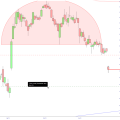The shocking incident earlier this year involving the Boeing 737 Max has placed The Boeing Company (BA) in the spotlight for all the wrong reasons. On January 5, the door plug of a commercial Boeing 737 Max 9 for Alaska Airlines blew off mid-air, revealing serious lapses in Boeing’s quality control and safety protocols.
This incident, traced back to a simple yet critical paperwork error, highlighted the potential dangers of administrative oversights in aviation manufacturing. Moreover, it interrupted Boeing’s progress in recovering from two deadly crashes of Max jets in 2018 and 2019. These crashes in Indonesia and Ethiopia, which claimed about 346 lives, are now back in the spotlight as well.
Detailed Analysis of the January 5th Accident
An Alaska Airlines flight operating a Boeing 737 Max 9 experienced a significant safety breach when a door plug came off 10 minutes after the flight took off from Portland, Oregon, on its way to Ontario, California. The root cause of this alarming event was a lack of paperwork. Evidence shows four bolts that hold the door plug in place were not installed before the plane left the factory in October, as the workers did not receive the necessary work order.
This administrative error, though seemingly minor, had the potential to endanger the lives of all passengers and crew on board, but luckily, the incident wasn’t fatal.
The door plug incident highlights significant issues with the quality of work along the Boeing assembly lines. These problems have drawn the attention of multiple federal investigations and whistleblower revelations, and have contributed to delays in jet deliveries, causing widespread disruptions for airlines and passengers worldwide.
Elizabeth Lund, BA’s Senior Vice President of Quality, addressed this issue at a press conference and admitted that the absence of paperwork led to administrative oversight. “The fact that one employee could not fill out one piece of paperwork in this condition and could result in an accident was shocking to all of us,” Lund stated.
The lack of paperwork was not new information, as it had been previously disclosed in testimony before the US Senate Commerce Committee by the head of the National Transportation Safety Board (NTSB). After the aircraft company “blatantly violated NTSB investigative regulations,” the agency issued a series of sanctions against Boeing.
So, Boeing’s disclosure of the information led to further complications with the NTSB, resulting in a reprimand and potential criminal probe referral to the Department of Justice.
The PR Team’s Struggle in Managing Continuous Crises
Boeing’s PR team has faced immense challenges in managing the fallout from continuous crises. The January 5th incident required immediate crisis management to mitigate further damage. However, their efforts were complicated by a subsequent reprimand from the NTSB for allegedly violating investigative protocols by sharing information prematurely.
BA acknowledged Lund’s recent remarks were a mistake. “We deeply regret that some of our comments, intended to make clear our responsibility in the accident and explain the actions we are taking, overstepped the NTSB’s role as the source of investigative information,” Boeing’s Kowal stated.
The strained relationship with regulatory bodies exacerbates the difficulty for Boeing’s PR team, which must now balance transparency with compliance while managing public perception and investor confidence.
Potential Financial and Reputational Damage
Administrative errors like the one seen on January 5 involving the Boeing 737 Max 9 can lead to significant financial and reputational damage. For BA, the immediate financial impact includes potential fines, legal fees, and the cost of corrective measures.
However, the long-term consequences can be even more damaging. Repeated safety issues erode trust in the brand, leading to a loss of customer confidence and potentially impacting future sales. Airlines may reconsider placing orders with Boeing and opt for competitors that are perceived as more reliable.
Investors are particularly sensitive to such risks. Boeing’s stock price is closely tied to its reputation for safety and reliability. Continued administrative errors and poor crisis management can enhance stock price volatility, affecting investor returns. The market tends to react negatively to news of safety breaches and regulatory reprimands, as seen in the aftermath of the door plug incident.
BA’s stock has plunged more than 24{3da602ca2e5ba97d747a870ebcce8c95d74f6ad8c291505a4dfd45401c18df38} over the past six months and nearly 29{3da602ca2e5ba97d747a870ebcce8c95d74f6ad8c291505a4dfd45401c18df38} year-to-date.
Bleak First-Quarter 2024 Results
BA faces increased scrutiny over the safety of its planes. As it deals with quality crises from the January 5th flight, Boeing reported a massive $355 million net loss for the first quarter that ended March 31, 2024. The company brought in revenue of $16.57 billion, a 7.5{3da602ca2e5ba97d747a870ebcce8c95d74f6ad8c291505a4dfd45401c18df38} year-over-year decline.
During the quarter, Boeing posted a 36{3da602ca2e5ba97d747a870ebcce8c95d74f6ad8c291505a4dfd45401c18df38} year-over-year decrease in commercial plane deliveries. This resulted in cash flow from operations dropping to negative $3.36 billion and non-GAAP free cash flow falling to negative $3.90 billion.
“Our first quarter results reflect the immediate actions we’ve taken to slow down 737 production to drive improvements in quality,” commented Dave Calhoun, Boeing’s President and CEO. “We will take the time necessary to strengthen our quality and safety management systems and this work will position us for a stronger and more stable future.”
“Near term, yes, we are in a tough moment,” Calhoun told its employees. “Lower deliveries can be difficult for our customers and for our financials. But safety and quality must and will come above all else.”
Wall Street also appears bearish about the aviation giant’s growth prospects. Analysts expect BA’s revenue for the second quarter (ended June 2024) to decrease 10.4{3da602ca2e5ba97d747a870ebcce8c95d74f6ad8c291505a4dfd45401c18df38} year-over-year to $17.71 billion. The company is projected to post a loss per share of $1.14 for the same period.
Bottom Line
The January 5th incident involving the Boeing 737 Max 9 has renewed scrutiny of air travel and Boeing’s planes. This incident highlighted a long series of safety and manufacturing issues accumulated for Boeing over the years, including two deadly crashes involving Max jets. These lapses pose serious safety risks and jeopardize the company’s reputation and financial stability.
Boeing’s repeated safety failures could have significant implications for Boeing’s future orders and stock performance. If the aviation giant cannot address these systemic issues and improve its crisis management strategies, it risks losing market share to competitors like Airbus SE (EADSY).
Investors must closely monitor BA’s response to these ongoing challenges. Effective and transparent communication, coupled with improvements in operational processes, will be crucial in restoring investor confidence. Boeing must also work to repair its relationship with regulatory bodies, ensuring compliance with all investigative protocols to avoid future reprimands and potential criminal investigations.
In conclusion, administrative errors at Boeing, exemplified by the January 5th incident, highlight the critical need for robust quality control and effective crisis management. The financial and reputational damage from such errors can considerably impact investor confidence. As Boeing navigates this problematic landscape, its ability to restore trust and demonstrate operational excellence will be vital to securing its future in the competitive aerospace industry.



